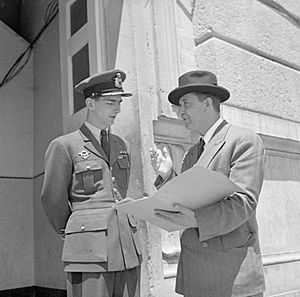Ivan Šubašić facts for kids
Quick facts for kids
Ivan Šubašić
|
|
|---|---|
 |
|
| Minister of Foreign Affairs | |
| In office 1 June 1944 – 17 October 1945 |
|
| Monarch | Peter II |
| President | Josip Broz Tito |
| Prime Minister | Josip Broz Tito |
| Preceded by | Božidar Purić |
| Succeeded by | Josip Smodlaka |
| 18th Prime Minister of Yugoslavia | |
| In office 8 July 1944 – 2 November 1944 |
|
| Monarch | Peter II |
| Preceded by | Božidar Purić |
| Succeeded by | Josip Broz Tito |
| Ban of the Croatian Banovina | |
| In office 24 August 1939 – 1941 |
|
| Deputy | Ivo Krbek |
| Preceded by | Position established |
| Succeeded by | Position abolished |
| Personal details | |
| Born | 7 May 1892 Vukova Gorica, Croatia-Slavonia, Austria-Hungary (now Croatia) |
| Died | 22 March 1955 (aged 62) Zagreb, PR Croatia, Yugoslavia (now Croatia) |
| Nationality | Yugoslav |
| Political party | Croatian Peasant Party (HSS) |
| Awards | Order of the White Eagle |
Ivan Šubašić (Serbo-Croatian Cyrillic: Иван Шубашић; 7 May 1892 – 22 March 1955) was an important politician from Yugoslavia. He was a Croat. He is famous for being the last Ban of Croatia. He also served as the Prime Minister of the royalist Yugoslav government that was in exile during World War II.
Contents
Early Life and Education
Ivan Šubašić was born in Vukova Gorica. This place was part of Austria-Hungary back then. He went to grammar and high school in Zagreb. Later, he studied theology at the University of Zagreb.
Military Service in World War I
During the First World War, he joined the Austro-Hungarian Army. He fought against Serbian forces near the Drina River. He was then sent to the Eastern Front. There, he decided to join the Russians. After that, he became a Yugoslav volunteer. He fought with the Serbian army on the Salonica front.
Becoming a Lawyer and Politician
After the war, Šubašić earned a law degree. He studied at the Faculty of Law, University of Zagreb. He then opened his own law office in Vrbovsko. There, he met Vladko Maček. He joined Maček's political group, the Croatian Peasant Party. In 1938, he was elected to the Yugoslav National Assembly. This was the parliament of the Kingdom of Yugoslavia.
Key Political Roles
Serving as Ban of Croatia
In August 1939, a big agreement was made. Vladko Maček and Yugoslav Prime Minister Dragiša Cvetković worked together. They decided to create an autonomous region called the Banovina of Croatia. This region included parts of modern-day Croatia, Bosnia and Herzegovina, and Vojvodina. It had a large Croat population. Ivan Šubašić was chosen as the first ban. This meant he was the head of this new government.
The Banovina of Croatia ended in April 1941. This happened when Axis powers invaded Yugoslavia. Šubašić then joined the Yugoslav government-in-exile. This government was based outside the country.
Role in the Government-in-Exile
While in exile, Šubašić first represented the Yugoslav government in the United States. During World War II, there was a growing disagreement. The royalist government was far from the main resistance group in Yugoslavia. This group was led by Josip Broz Tito and his Partisans.
Winston Churchill decided to help solve this problem. Šubašić, who was a Croat and not a Communist, was chosen as the new prime minister. His job was to find a way for Tito's forces to work with the monarchy. Tito's Partisans were already controlling many areas in Yugoslavia. The monarchy preferred Draža Mihailović and his Serb-led Chetniks.
Šubašić publicly said he did not support Mihailović. He then met with Tito on the island of Vis. They signed an important agreement called the Tito–Šubašić agreement. This agreement recognized the Partisans as the official armed forces of Yugoslavia. In return, the Partisans formally joined the new government.
Šubašić remained prime minister until November 2, 1944. At that time, Tito officially became the new prime minister. Šubašić then served as the foreign minister in Tito's government. He resigned in October 1945. He did not agree with the new government's Communist policies.
Later Life and Legacy
After leaving politics, Ivan Šubašić lived a quiet life. He passed away in 1955 in Zagreb. About 10,000 people attended his funeral. He is buried in Mirogoj Cemetery.


